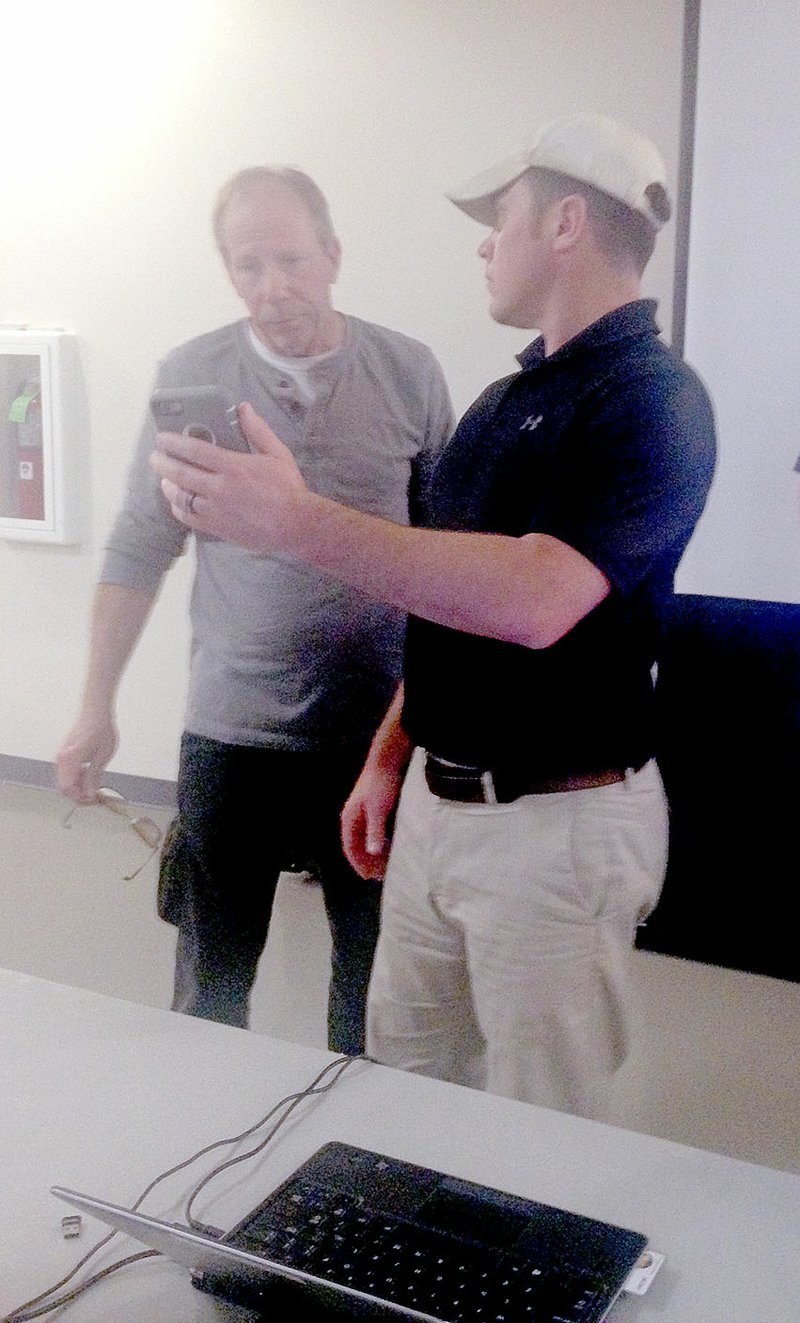Having trained storm spotters out in the field helps meteorologists identify rotation and impending bad weather.
While storm spotters can serve as the eyes and ears for meteorologists, they help ferret out bad information as well.
National Weather Service meteorologist Doug Cramer, who works in the Springfield office, told a crowd of nearly 90 people that spotters can help confirm weather conditions in different scenarios. Cramer was on hand to train weather spotters.
A developing situation was reported, with damage taking place at McDonald's in Rogers. A photo and a report came in, prompting Cramer to contact McDonald County Emergency Management Agency Director Gregg Sweeten. With the reported damaging winds headed north, Cramer asked about conditions in the field. However, spotters could not confirm any impending weather. Cramer pressed that he had a photo of the damaged McDonald's and asked if the spotters were certain about what they were seeing. Sweeten said they just were not seeing any strong conditions developing. After further verification, the Weather Service determined that the photo was a spoof, which occurred at a different time and in a different state.
"That's (one reason) why we have storm spotters," Cramer said.
The storm spotter training on April 3 was hosted by the National Weather Service, which hosts the training in Pineville once a year.
Sweeten said the crowd was the second largest to attend. The storm-spotter training has been offered for more than 20 years, although he was uncertain as to the first year it began. The spring training in 2011 proved to draw the largest crowd, Sweeten said. That training occurred right after the Joplin tornado.
Fire and law personnel, CERT members, amateur radio operators and folks interested in learning more about storm spotting attended the training at the Pineville Community Center. By a show of hands, Cramer estimated that about 55 percent of those on hand were first-time attendees.
Cramer said Southwest Missouri is rated No. 2 in flash flooding areas in the country. McDonald County is the second hot spot in the state for tornadic outbreaks.
The meteorologist grew up near Parson, Kan., attended college and worked in Mississippi for a year and a half, then returned to the area in 2002 to work in the National Weather Service's office in Springfield. He travels to 37 different counties in southeast Kansas and Missouri to host these types of training.
During the training, those on hand had the opportunity to learn more about a variety of storm spotter tips. Cramer discussed several topics, including squall lines and super cells, wall clouds and shelf clouds.
Squall lines, in general, are capable of producing EF 0, 1 and 2 tornadoes; isolated super cells have the potential to producing EF 3, 4 and 5 tornadoes.
Outlooks occur two to seven days out. Watches are released one to six hours out, which mean the ingredients exist for potential severe weather. A warning is usually issued within one hour or less, Cramer said.
A tornado needs heat and moisture, and a super cell has a slanting, rotating updraft, which creates longevity for the storm.
Only 15 to 20 percent of super cells produce tornadoes, but when they do, they pack a deadly punch.
Cramer asked attendees what they look for when weather conditions begin to change.
Attendees said they watch the clouds to look for patterns, shelf or wall clouds; tap into the National Weather Service, observe sudden warm temperatures, listen to a scanner and radio communications, make note of reports coming from other storm spotters, and look at the color of the sky.
Cramer asked spotters to be specific when reporting changing weather conditions. Information from spotters help motivate people to take action, he said.
"I have worked a lot of outbreaks and I love confirmation from a spotter. When the warning issues, when we have a confirmation and specifics, that's when people act," he said. "We really appreciate the reports."
Cramer asked spotters to be able to see what direction the tornado or super cell is moving; how fast the wind is moving and what type of damage has been sustained; offer a detailed description of the type of clouds; exact location of a flooding situation; and descriptive size of hail, related to coin size.
Sweeten encouraged attendees to call in changing weather conditions. Other spotters can be sent out in the field to verify what's been reported.
Cramer cautioned to be observant of situational awareness -- know where you are, know which direction the road jags and where the tornado is headed.
Even as a trained meteorologist, Cramer found himself in an extremely dangerous situation in Picher, Okla., on Mother's Day weekend several years ago. He had already taught storm spotter classes for six or seven years, but didn't keep abreast of his situational awareness. Trying to get closer to see the tornado, Cramer didn't know the road jagged and went a different direction than he thought. He headed into the storm and grapefruit-sized hail pummeled his car.
The situation was extremely dangerous, Cramer said. He cautioned others to keep a level head when out in the field. He also cautioned about keeping a safe distance, knowing which direction the tornado is headed, and knowing that tornadoes can quickly turn.
"Stay safe," he said. "Rights are common."
Two storm spotters, who were contracted by the Weather Service, were killed March 29 in Texas while chasing a storm. Reports state they drove through an intersection and a stop sign and hit another car during a storm chase. Three storm spotters were killed.
The two in the first vehicle -- Kelley Williamson, 57, and Randall Yarnall, 55, were from Cassville, Cramer said.
General News on 04/20/2017
